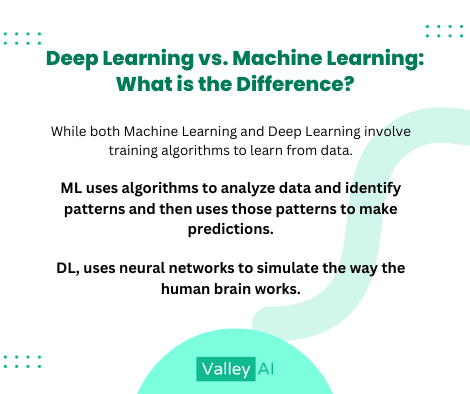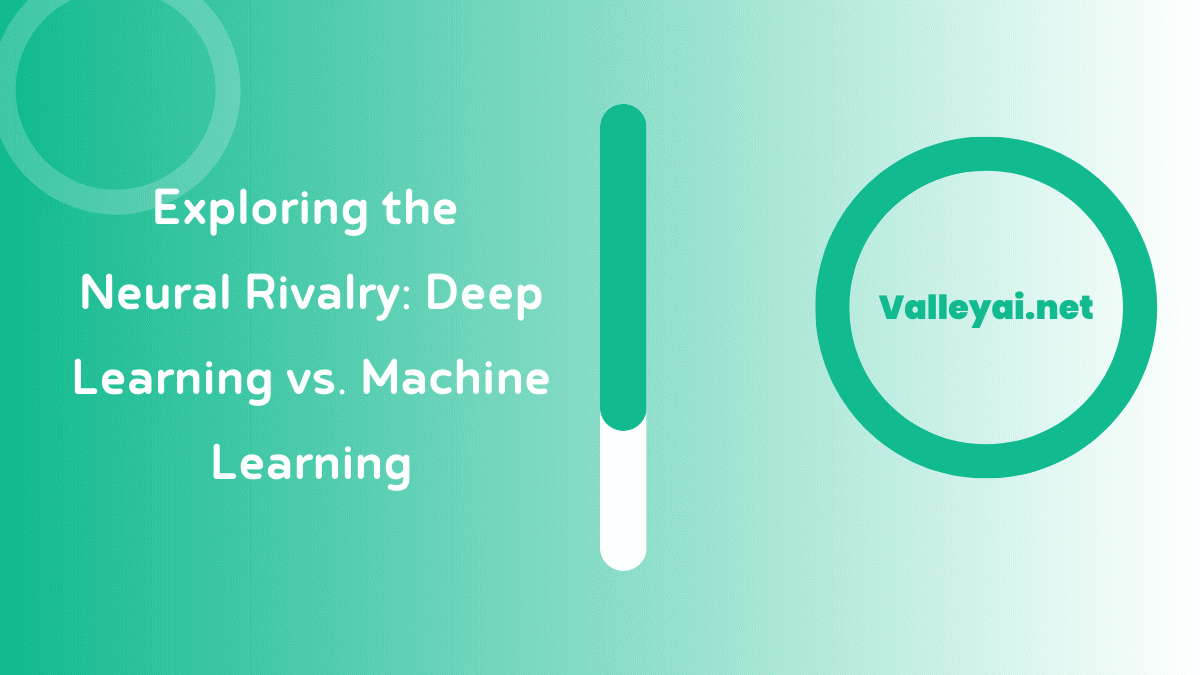Are you confused about the difference between deep learning and machine learning? I am excited to share our comprehensive guide on deep learning vs. machine learning.
Machine learning and deep learning are widely recognized concepts that have been around for a substantial period of time. Although they are often used interchangeably, they are actually two distinct concepts.
ML and DL are both subsets of artificial intelligence (AI) and both involve teaching machines to learn from data. In this guide, I will cover everything you need to know about these two popular subsets of artificial intelligence. You will understand which one is the right fit for your business.
Deep Learning vs. Machine Learning: What is the Difference?

Machine learning uses algorithms to analyze data and identify patterns, and it then uses those patterns to make predictions about new data. Deep learning, in contrast, uses neural networks to simulate the way the human brain works. It can identify even more complex patterns than machine learning, and it can make more accurate predictions as a result.
What is Machine Learning?
Machine learning is a subset of Artificial Intelligence that involves training algorithms to learn patterns from data. These algorithms use statistical models to analyze data and make predictions based on that analysis.
Machine learning can be categorized into three distinct types: supervised learning, unsupervised learning, and reinforcement learning.
Supervised Learning
Supervised learning entails training an algorithm using a dataset that has been labeled. The algorithm is given a set of inputs and expected outputs. It then uses these inputs and outputs to learn how to make predictions on new, unseen data.
Unsupervised Learning
Unsupervised learning encompasses training an algorithm using an unlabeled dataset. In this case, the algorithm must discover patterns in the data without any explicit guidance. This type of learning is commonly employed for tasks such as clustering and anomaly detection.
Reinforcement Learning
Reinforcement learning involves training an algorithm to make decisions based on a system of rewards and punishments. The algorithm learns to maximize its rewards over time by taking actions that lead to positive outcomes.
What is Deep Learning?
Deep learning is a subset of Machine Learning that involves training algorithms called neural networks to learn patterns from data. Neural networks mimic the structure of the human brain and are specifically designed to identify patterns within data.
Deep learning is commonly utilized for tasks such as image and speech recognition, natural language processing, and autonomous vehicles.
Neural Networks
Neural networks consist of layers comprising interconnected nodes. Each node is responsible for performing a specific calculation. The output of one layer becomes the input for the next layer, allowing the neural network to learn increasingly complex patterns.
Deep Neural Networks
Deep neural networks are neural networks that have multiple hidden layers. They are able to learn more complex features than shallow neural networks, which have only one hidden layer.
Recurrent Neural Networks
Recurrent neural networks (RNNs) are a type of neural network that is well-suited for sequential data by maintaining an internal state, or “memory,” that captures information about previous inputs. such as speech and text.
They are effective in modeling temporal dependencies and are widely used in tasks such as language modeling and speech recognition. Variants like LSTM and GRU address issues of vanishing gradients and have improved performance.
Long Short-Term Memory Networks
Long short-term memory networks (LSTMs) are a type of RNN that are particularly well-suited for tasks that require understanding long-term dependencies in the input data. They use a gating mechanism to control the flow of information through the network, which allows them to selectively remember or forget information from previous time steps.
Key Differences Between Machine Learning and Deep Learning
While both machine learning and deep learning involve training algorithms to learn from data, there are a few key differences between the two.
Data Requirements
Machine learning algorithms can be trained on small datasets, while Deep Learning algorithms require large amounts of data to be effective. Deep Learning algorithms are designed to find patterns in data, and the more data they have, the better they can learn.
Hardware Requirements
Deep learning algorithms require specialized hardware such as GPUs to be trained effectively. This is because the training process involves performing a large number of matrix multiplications, which GPUs are designed to handle efficiently.
Complexity of data
Deep learning algorithms are of a higher complexity compared to Machine Learning algorithms. They require a greater level of expertise to design and train effectively.
Interpretability
One downside of deep learning algorithms is that they can be difficult to interpret. It can be difficult to understand how a neural network arrived at a particular prediction, which can be a concern in applications such as healthcare or finance. In contrast, traditional machine learning algorithms can often be more transparent and interpretable.
Conclusion
In conclusion, machine learning and deep learning are two different subsets of Artificial Intelligence that involve training algorithms to learn from data. While both are valuable in their own right, they have different data and hardware requirements, as well as differing levels of complexity. I hope this guide has helped you understand the differences between these two popular AI subsets.
FAQs: Machine Learning vs Deep Learning
Can deep learning be used without machine learning?
No, deep learning is a subset of machine learning. It’s a more specialized form of machine learning that uses neural networks to simulate the way the human brain works.
Is deep learning better than machine learning?
It depends on the task at hand. Deep learning is particularly well-suited for complex, high-dimensional data such as images, audio, and text. However, it requires a large amount of data to train effectively and can be computationally intensive.
Can deep learning be used for natural language processing?
Yes, deep learning is often used for natural language processing tasks such as text classification, sentiment analysis, and language translation.
What is the goal of machine learning?
The goal of machine learning is to enable machines to make predictions or decisions without being explicitly programmed to do so.
Which algorithm requires larger datasets, deep learning or machine learning?
Deep learning algorithms require larger datasets to learn effectively than machine learning algorithms.
- Understanding the Landscape of Cloud Vulnerability Management - March 25, 2024
- Quality Assurance Strategies for Startups: Ensuring Software Reliability - March 5, 2024
- Working of NLP to Improve Copywriting in AI Paraphrasing Tool - February 28, 2024

